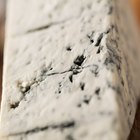
Freezing a block of cheese seems like a smart strategy to save time and money, but using it straight from the freezer is not as simple as you might think. You should slightly thaw the cheese before you grate it, but don't expect it to easily fall into shreds. Instead, grate the cheese before you freeze it, especially if it's a high-moisture cheese, such as mozzarella.
Making the Grate
Cheese is easiest to grate if you allow it to thaw somewhat first. Place a frozen block of cheese in your refrigerator at 40 degrees Fahrenheit or cooler. The cheese will be soft enough to grate within a few hours. Freezing cheese causes it to dry out slightly and become crumbly or mealy, so even with thawing, the cheese may not grate well. You might not even need to grate the cheese. If you merely cut it, it will crumble into small pieces. Set it on a cutting board and cut the pieces as if you were dicing vegetables. The pieces won't be quite as small as shredded cheese, but they work fine for melting in a casserole or soup.
Melt It
Frozen cheese, in any form, is not particularly pretty when thawed, but it tastes fine. You can't cut it into nice cubes for a salad, for example. Nor can you create fine, even shreds for tacos, because it crumbles. Use previously frozen cheese for cooked dishes instead. As it melts, any imperfections in appearance will disappear.
Cheese Choices
The best types of cheese for freezing are hard cheeses, such as gouda, Parmesan and cheddar. These cheeses have low moisture and tend to retain their flavor and texture best. These cheeses are also the best candidates for grating. Avoid freezing soft, delicate cheeses, which may become watery or mushy in the freezer or develop off-flavors. Freeze small blocks of cheese, weighing no more than 1/2 pound. Wrap cheeses tightly in foil or plastic wrap or seal them in heavy freezer bags. Freeze cheese for no more than six months.
Grate, Then Freeze
A better strategy for freezing cheese is to grate it before you freeze it. Grate the cheese and toss it with a bit of cornstarch in a bowl. The cornstarch prevents it from clumping together in the freezer. Pack the grated cheese in heavy freezer bags or vacuum-seal bags. Squeeze out as much air as you can, and label the packages with the date. Use them within three to six months. Thaw shredded cheese in the refrigerator for a few hours before use.
Related Articles

How to Freeze Cheeses

How to Store Cheese

How to Dry Cheese

How to Make Melted Cheese Using Cubes ...

How to Freeze Mascarpone

How to Store Parmigiano Reggiano

How Long Can You Refrigerate Nacho ...
Homemade Mozzarella Sticks with String ...
How to Pan-Fry Cheese

How to Defrost Frozen Mozzarella

What Types of Cheeses Are Unpasteurized?

How to Liquefy Cheese

Does Blue Cheese Spoil?

The Difference Between Fresh Cheese & ...

The Best Melting Cheeses

What Good Bacteria Is in Cheese?

How Can I Get Brie to the Right ...
Can I Eat My Cheddar Cheese Past the ...

Substitute for Shredded Parmesan Cheese

Can You Substitute Mascarpone With ...
References
- Still Tasty: Can You Freeze Cheese Successfully
- The Kitchn: Can You, Should You Freeze Cheese: On Freezing Cheese
- North Dakota State University Extension: Freezing Dairy Products, Eggs and Other Products
- National Center for Home Food Preservation: Freezing Cheese
- The Nibble: Grated Cheese: It's Great to Grate!
Writer Bio
Julie Christensen is a food writer, caterer, and mom-chef. She's the creator of MarmaladeMom.org, dedicated to family fun and delicious food, and released a book titled "More Than Pot Roast: Fast, Fresh Slow Cooker Recipes."
Photo Credits
Brand X Pictures/Stockbyte/Getty Images